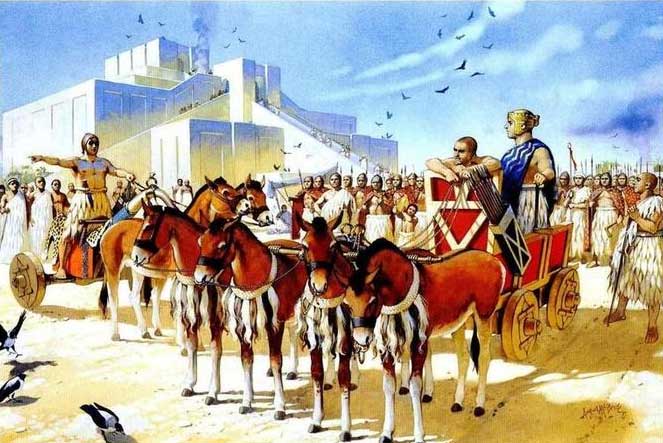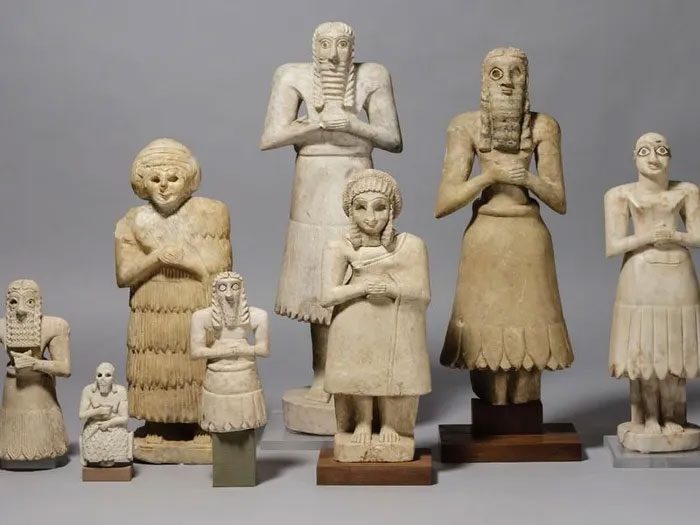The Sumerian Civilization is the earliest known civilization in human history. Its location is in the Mesopotamia region, situated between the Tigris and Euphrates rivers, from approximately 4500 to 1900 BC.
By the end of the 4th millennium BC, the Sumerian civilization consisted of 23 major city-states and 10 smaller independent city-states, separated by canals and stone boundary walls. Each city-state had a central temple dedicated to its specific patron deity, governed by a high priest (ensi) or a king (lugal) who had deep connections to the religious sites of the city-state. The city-states frequently waged wars against each other but could also form alliances.

The Sumerian civilization surpassed the preceding dark age.
The Sumerian civilization achieved remarkable advancements, far exceeding the earlier dark ages. Even today, modern society inherits many legacies from ancient Sumer. Some “conspiracy theories” even suggest that the Sumerian civilization received assistance from extraterrestrials (?)
Regarding education, the Sumerians established schools after inventing writing around the end of the 4th millennium BC (approximately 3150 BC). They referred to schools as “houses of clay tablets,” the teachers as fathers, the students as children, and the assistants as older brothers. Students were disciplined with rods or sticks.

The Sumerians opened schools after inventing writing. (Illustrative image).
In terms of politics and law, they organized democratic institutions similar to a bicameral legislature: clay tablets dating back to 3000 BC record debates among armed men deciding whether to seek peace or war, similar to a House of Commons. The decisions made in this assembly had to be presented to the Council of Elders, where the king’s opinion was final, akin to a Senate. They organized separate trials for juvenile offenders and adults.
The Sumerians developed a complex measurement system around 4000 BC. This advanced measurement system led to the emergence of arithmetic, geometry, and algebra. From about 2600 BC, the Sumerians wrote numerous multiplication tables on clay tablets and solved geometric problems and division calculations. The earliest traces of Babylonian numerals also originate from this period. The period between 2700–2300 BC saw the first appearance of multiplication tables, including a table with continuous columns delineating continuous orders of magnitude in a sexagesimal number system.
The Sumerians were the first to use a positional number system. There are also anecdotal evidence suggesting that the Sumerians may have used a form of sliding ruler for astronomical calculations. They were the first to calculate the area of a triangle and the volume of a cylinder.
The Sumerians adopted an agricultural lifestyle possibly as early as 5000 to 4500 BC, demonstrating several basic agricultural techniques, including organized irrigation, large-scale concentrated farming, and the use of plows and professional labor. They cultivated barley, peas, lentils, wheat, dates, onions, garlic, lettuce, leeks, and mustard. The Sumerians fished for various types of fish and hunted birds and gazelles.
The Sumerians also domesticated and herded sheep, cattle, goats, and pigs. They had a vast ancient trade network centered around the Persian Gulf region.
The technology and handicrafts of Sumer at that time were also highly developed. Examples of Sumerian technology include: the wheel, cuneiform writing, arithmetic and geometry, irrigation systems, Sumerian ships, lunar-solar calendars, copper, leather, saws, chisels, hammers, support columns, tin, nails, pins, jewelry, hoes, axes, knives, spearheads, arrowheads, swords, glue, daggers, leather water bags, bags, saddles, armor, quivers, chariots, scabbards, shoes, sandals, hooks, and steles.
The Sumerians believed in polytheism or the worship of many deities. There was no unified pantheon for the entire empire; each city-state had its patron deity, temple, and distinct priest-king. The Sumerians were likely the first to record their beliefs. According to them, humans were created from clay to serve the gods, meaning that humanity must serve religion rather than religion serving humanity.

The Sumerians were likely the first to record their beliefs.
The structures built during the Sumerian era were made of flat-convex mud bricks, which were not mixed with mortar and thus easily deteriorated over time. The Sumerians also constructed monumental buildings such as ziggurats, which served religious and astronomical purposes at that time.
Nearly continuous wars between Sumerian city-states over 2000 years fostered the development of military techniques and technologies to a high degree. Sumerian armies were primarily composed of infantry. The infantry soldiers carried spears, wore bronze helmets, and carried shields made of leather or wicker. Soldiers wielding spears were arranged in formations similar to the phalanx, which required training and discipline; this suggests that the Sumerians may have employed professional warriors. They also used horse-drawn and ox-drawn carts as mobile battle chariots.
In 1940 BC, the Elamites invaded Sumer and plundered its city-states. Later, during the reign of Hammurabi of Babylonia, the Babylonians unified the Mesopotamian lands, leading to the downfall of the Sumerians. Around 1700 BC, the Sumerians were assimilated into the Assyrian and Babylonian peoples.




















































